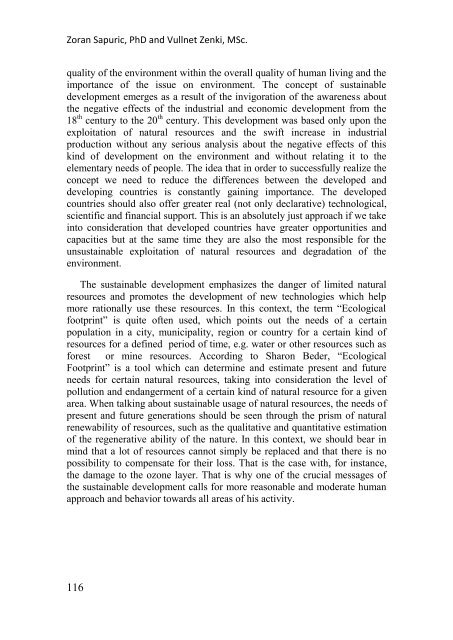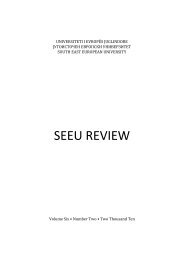SEEU Review vol. 5 Nr. 2 (pdf) - South East European University
SEEU Review vol. 5 Nr. 2 (pdf) - South East European University
SEEU Review vol. 5 Nr. 2 (pdf) - South East European University
You also want an ePaper? Increase the reach of your titles
YUMPU automatically turns print PDFs into web optimized ePapers that Google loves.
Zoran Sapuric, PhD and Vullnet Zenki, MSc.<br />
quality of the environment within the overall quality of human living and the<br />
importance of the issue on environment. The concept of sustainable<br />
development emerges as a result of the invigoration of the awareness about<br />
the negative effects of the industrial and economic development from the<br />
18 th century to the 20 th century. This development was based only upon the<br />
exploitation of natural resources and the swift increase in industrial<br />
production without any serious analysis about the negative effects of this<br />
kind of development on the environment and without relating it to the<br />
elementary needs of people. The idea that in order to successfully realize the<br />
concept we need to reduce the differences between the developed and<br />
developing countries is constantly gaining importance. The developed<br />
countries should also offer greater real (not only declarative) technological,<br />
scientific and financial support. This is an absolutely just approach if we take<br />
into consideration that developed countries have greater opportunities and<br />
capacities but at the same time they are also the most responsible for the<br />
unsustainable exploitation of natural resources and degradation of the<br />
environment.<br />
The sustainable development emphasizes the danger of limited natural<br />
resources and promotes the development of new technologies which help<br />
more rationally use these resources. In this context, the term “Ecological<br />
footprint” is quite often used, which points out the needs of a certain<br />
population in a city, municipality, region or country for a certain kind of<br />
resources for a defined period of time, e.g. water or other resources such as<br />
forest or mine resources. According to Sharon Beder, “Ecological<br />
Footprint” is a tool which can determine and estimate present and future<br />
needs for certain natural resources, taking into consideration the level of<br />
pollution and endangerment of a certain kind of natural resource for a given<br />
area. When talking about sustainable usage of natural resources, the needs of<br />
present and future generations should be seen through the prism of natural<br />
renewability of resources, such as the qualitative and quantitative estimation<br />
of the regenerative ability of the nature. In this context, we should bear in<br />
mind that a lot of resources cannot simply be replaced and that there is no<br />
possibility to compensate for their loss. That is the case with, for instance,<br />
the damage to the ozone layer. That is why one of the crucial messages of<br />
the sustainable development calls for more reasonable and moderate human<br />
approach and behavior towards all areas of his activity.<br />
116

















